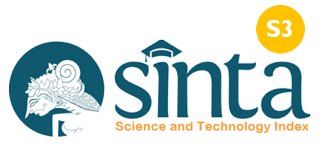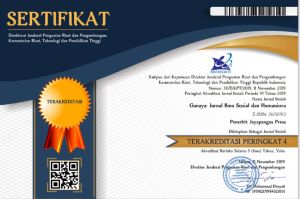Peran Pasraman Sebagai Lembaga Pendidikan Formal Dalam Membentuk Karakter Religius Peserta Didik
DOI:
https://doi.org/10.37329/cetta.v4i4.3096Keywords:
Pasraman, Formal Education, Religious CharacterAbstract
Education in Indonesia is an activity that must be carried out by children, in Indonesia itself children are required to get education at school for 12 years, but education is not only in school but can be obtained from the environment, and also family. Education is divided into three namely formal, non-formal, and informal education. Religious education is something that is very important for children to get which can support the behavior and behavior and manners of children. Hindu religious education has a very important role and has a share in achieving the goals of this nation. Formal Pasraman as an educational institution based on Hinduism has a very important role in shaping the character of students. This research uses qualitative research with literature study. The results of this study indicate that Pasraman activities, as a formal educational institution, are an effort to provide education to the younger generation of Hindus in a simple form in accordance with local traditions, customs, dresta, conditions. With this formal pasraman, it is hoped that the younger generation of Hindus can get more Hindu religious education, and no longer hesitate because the formal pasraman has the same position as formal schools in general, so that the goals of this nation can be achieved and have the next generation of the nation that has a religious spiritual character.References
Adlini, M. N., Dinda, A. H., Yulinda, S., Chotimah, O., & Merliyana, S. J. (2021). Metode penelitian kualitatif studi pustaka. Edumaspul: Jurnal Pendidikan, 6(1), 974–980.
Ansori, M. (2020). Dimensi HAM dalam Undang-undang Sistem Pendidikan Nasional Nomor 20 Tahun 2003. IAIFA Press.
Atmaja, I. (n.d.). Made Nada (2010). Etika Hindu. Surabaya: Paramita.
Gunawijaya, I. W. T., & Srilaksmi, N. K. T. (2020). Hambatan Pembelajaran Agama Hindu Terhadap Siswa Tuna Netra di Panti Mahatmia. Cetta: Jurnal Ilmu Pendidikan, 3(3), 510–520.
Maswinarta, W. (1999). Sarwa Dharsana Samggraha, Enam Filsafat Hindu. Surabaya: Paramita.
Perni, N. N. (2017). Pentingnya Menciptakan Suasana Pembelajaran Bagi Anak Usia Dini. Pratama Widya: Jurnal Pendidikan Anak Usia Dini, 2(2), 45–50.
Purnomo, I. M. B. A., & Indiani, N. M. (2021). Eksistensi Peraturan Menteri Agama (PMA) Nomor 10 Tahun 2020 Sebagai Penguatan Pendidikan Keagamaan Hindu Di Indonesia. Purwadita: Jurnal Agama Dan Budaya, 5(2), 181–190.
Sari, E. S., Alfiyah, A., & Sugiarto, F. (2021). Analisis Kebijakan Pemerintah Dalam Pendidikan Agama Dan Keagamaan Di Indonesia. Awwaliyah: Jurnal Pendidikan Guru Madrasah Ibtidaiyah, 4(1), 1–9.
Sari, M., & Asmendri, A. (2020). Penelitian kepustakaan (library research) dalam penelitian pendidikan IPA. Natural Science, 6(1), 41–53.
Sariani, R. (2020). Peranan Pasraman Dalam Meningkatkan Sradha Dan Bhakti Anak-Anak. WIDYALAYA: Jurnal Ilmu Pendidikan, 1(2), 201–208.
Siryadana, I. M. (2020). Pembentukan Karakter Anak Melalui Kegiatan Pasraman Lascarya Parama Seva di Desa Tianyar Kecamatan Kubu Kabupaten Karangasem. Vidya Wertta: Media Komunikasi Universitas Hindu Indonesia, 3(2), 52–70.
Untara, I. M. G. S., & Rahayu, N. W. S. (2020). Bissu: Ancient Bugis Priest (Perspective On The Influence Of Hindu Civilization In Bugis Land). Vidyottama Sanatana: International Journal of Hindu Science and Religious Studies, 4(2), 243–249.
Winanti, N. P. (2021). Pasraman Sebagai Upaya Peningkatan Mutu Pendidikan Berbasis Budaya Dan Spiritual. Jurnal Penelitian Agama Hindu, 5(2), 106–114.
Yuniastuti, N. W., Trisdyani, N. L. P., & Suadnyana, I. B. P. E. (2020). Pertunjukan Topeng Bondres Sebagai Media Pendidikan Agama Hindu. Maha Widya Duta: Jurnal Penerangan Agama, Pariwisata Budaya, Dan Ilmu Komunikasi, 4(1), 23–34.
Downloads
Published
How to Cite
Issue
Section
License
Copyright (c) 2021 Ryan Naraditya, I Made Paramarta

This work is licensed under a Creative Commons Attribution-ShareAlike 4.0 International License.
An author who publishes in the Cetta : Jurnal Ilmu Pendidikan agrees to the following terms:
- Author retains the copyright and grants the journal the right of first publication of the work simultaneously licensed under the Creative Commons Attribution-ShareAlike 4.0 License that allows others to share the work with an acknowledgement of the work's authorship and initial publication in this journal
- Author is able to enter into separate, additional contractual arrangements for the non-exclusive distribution of the journal's published version of the work (e.g., post it to an institutional repository or publish it in a book) with the acknowledgement of its initial publication in this journal.
- Author is permitted and encouraged to post his/her work online (e.g., in institutional repositories or on their website) prior to and during the submission process, as it can lead to productive exchanges, as well as earlier and greater citation of the published work (See The Effect of Open Access).
Read more about the Creative Commons Attribution-ShareAlike 4.0 Licence here: https://creativecommons.org/licenses/by-sa/4.0/.





